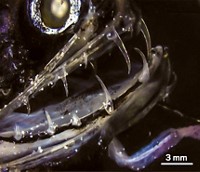Advertisement
Grab your lab coat. Let's get started
Welcome!
Welcome!
Create an account below to get 6 C&EN articles per month, receive newsletters and more - all free.
It seems this is your first time logging in online. Please enter the following information to continue.
As an ACS member you automatically get access to this site. All we need is few more details to create your reading experience.
Not you? Sign in with a different account.
Not you? Sign in with a different account.
ERROR 1
ERROR 1
ERROR 2
ERROR 2
ERROR 2
ERROR 2
ERROR 2
Password and Confirm password must match.
If you have an ACS member number, please enter it here so we can link this account to your membership. (optional)
ERROR 2
ACS values your privacy. By submitting your information, you are gaining access to C&EN and subscribing to our weekly newsletter. We use the information you provide to make your reading experience better, and we will never sell your data to third party members.
Materials
Secret of White Beetle Revealed
Insect's bright white scales are due to randomly oriented fibers
by Mitch Jacoby
January 22, 2007
| A version of this story appeared in
Volume 85, Issue 4
What makes a white beetle so bright white? A new study shows that the brilliance originates from a network of 250-nm-thick fibers found in the interior of the beetle's scales. The investigation provides an explanation for one of nature's curiosities and may suggest new ways of making bright white ultrathin structures for display applications.
White beetles owe their bright appearance to a network of fibers that comprise the scales that cover their bodies.

White beetles owe their bright appearance to a network of fibers that comprise the scales that cover their bodies.
Vivid colors and dazzling patterns are commonplace among species in the animal kingdom. But animals featuring luminescent white coloring are uncommon. Cyphochilus, a beetle found in Thailand and elsewhere in Southeast Asia, is an unusually white critter. Experts propose that the whiteness of the beetle's thin scales, which cover its body, head, and legs, aids the bug in mimicking local white fungi and serves as a form of camouflage. The origin of that whiteness and the beetle's secret for deriving so much brightness from its scales, which are thinner than synthetic bright white products, have now been revealed.
On the basis of electron microscopy analysis, researchers in England report that the beetle's scales, which typically are 250 µm long, 100 µm wide, and just 5 µm thick, are composed of a tangle of randomly oriented interconnecting cuticle-like fibers 250 nm thick. According to the research group, which includes physicists Pete Vukusic and Joseph Noyes of the University of Exeter and Benny Hallam of Imerys Minerals, in Cornwall, the lack of order and periodicity in the fiber network and the fibers' sparse packing arrangement and large contrast in refractive index relative to air are the sources of the beetle's bright white appearance (Science 2007, 315, 348).
Unlike the hues of colorful animal wings and other objects, which often owe their striking appearance to pigments or periodic structural order, whiteness is usually the result of random structure and lack of order. Vukusic explains that, similar to the aperiodic structures characteristic of the components of snow and milk, the irregularly spaced fibers in the beetle scales efficiently scatter all wavelengths of incident light, which causes the scales to appear very white.
Considering that they are only 5 µm thick, the beetle scales are remarkably bright white, the team stresses. To quantify that claim, the group used industry-standard whiteness rating methods and found that common uncoated paper samples, which contain disordered bleached cellulose fibers, are only 8% brighter than the beetle scales—yet they are often more than 25 times thicker. (Paper brightness is often boosted by applying coatings of crystalline materials and fluorescent dyes.)
The scattering efficiency of the fiber network might one day lead to applications in display technologies—for example, as ultrathin, flexible backing layers for white light-emitting devices.
"Nature has demonstrated that structures can be extremely thin and yet very bright," Vukusic says. "It's up to us to take these ideas and figure out where to apply them."





Join the conversation
Contact the reporter
Submit a Letter to the Editor for publication
Engage with us on Twitter